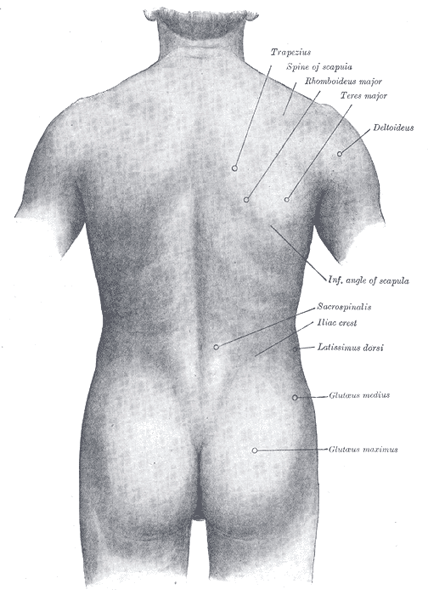-
3. Surface Anatomy of the Back
Close- TABLE OF CONTENTS
- I. Embryology
- II. Osteology
- III. Syndesmology
- IV. Myology
- V. Angiology
- VI. The Arteries
- VII. The Veins
- VIII. The Lymphatic System
- IX. Neurology
- X. The Organs of the Senses and the Common Integument
- XI. Splanchnology
- XII. Surface Anatomy and Surface Markings
- BIBLIOGRAPHIC RECORD
- LIST OF ILLUSTRATIONS
- SUBJECT INDEX

FIG. 1211 - Surface anatomy of the back. Bones.—The only subcutaneous parts of the vertebral column are the apices of the spinous processes. These are distinguishable at the bottom of a furrow which runs down the middle line of the back from the external occipital protuberance to the middle of the sacrum. In the cervical region the furrow is broad and ends below in a conspicuous projection caused by the spinous processes of the seventh cervical and first thoracic vertebræ. Above this, the spinous process of the sixth cervical vertebra sometimes forms a projection; the other cervical spinous processes are sunken, but that of the axis can be felt. In the thoracic region the furrow is shallow and during stooping disappears, and then the spinous processes become more or less visible; the markings produced by them are small and close together. In the lumbar region the furrow is deep and the situations of the spinous processes are frequently indicated by little pits or depressions, especially when the muscles in the loins are well-developed. In the sacral region the furrow is shallower, presenting a flattened area which ends below at the most prominent part of the dorsal surface of the sacrum, i. e., the spinous process of the third sacral vertebra. At the bottom of the sacral furrow the irregular dorsal surface of the bone may be felt, and below this, in the deep groove running to the anus, the coccyx. The only other portions of the vertebral column which can be felt from the surface are the transverse processes of the first, sixth, and seventh cervical vertebræ. Muscles.—The muscles proper of the back are so obscured by those of the upper extremity (Fig. 1211) that they have very little influence on surface form. The Splenii by their divergence serve to broaden out the upper part of the back of the neck and produce a fulness in this situation. In the loin the Sacrospinales, bound down by the lumbodorsal fascia, form rounded vertical eminences which determine the depth of the spinal furrow and taper below to a point on the dorsal surface the sacrum. The continuations of the Sacrospinales in the lower thoracic region form flattened planes which are gradually lost on passing upward.
Subscribe to the "News" RSS Feed 
TOP ۞
